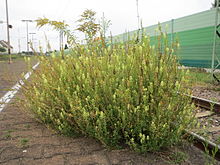Yellow woof
| Yellow woof | ||||||||||||
|---|---|---|---|---|---|---|---|---|---|---|---|---|

Yellow woof ( Reseda lutea ) |
||||||||||||
| Systematics | ||||||||||||
|
||||||||||||
| Scientific name | ||||||||||||
| Reseda lutea | ||||||||||||
| L. |
The Yellow Wau ( Reseda lutea ), also Yellow rocket or Yellow mignonette called, is a species of the genus Reseda within the family of mignonette (Resedaceae). It is widespread in Europe .
Description and ecology
Vegetative characteristics
The yellow woof grows as a deciduous, annual to perennial herbaceous plant and reaches heights of 30 to 70 centimeters. The upright, richly leafy stem can be simple or branched. The Yellow Wau has one to two pinnate or three-part leaves with long, narrow sections and a narrow, usually wavy or curly edge. The basal leaves are arranged like a rosette . They wither relatively soon.
Generative characteristics
The flowering period extends from June to September. The flowers are on flower stalks in initially short, later elongated, dense racemose inflorescences . The hermaphrodite, odorless flowers are rarely five, usually six-fold with a double flower envelope . The rarely five, usually six petals are light yellow. The stamens open one by one and carry out growth movements.
The upright capsule fruits are oblong with a length of 8 to 15 millimeters.
The number of chromosomes is 2n = 48.
ecology
The pollination is done by insects , even self-pollination occurs.

Occurrence
The yellow woof is widespread in Europe . Its distribution area extends from Macaronesia , North Africa , South, Central and Eastern Europe to the Caucasus , Western Asia , Central Asia and Siberia . He is a neophyte in other countries.
It is very common in Austria. In Germany it occurs in the south widespread, in the north as a neophyte scattered (especially on railway lines and in ports). In Germany it belongs to the archaeophytes . In Central Europe it is absent in the lowlands and in the higher low mountain ranges, towards the east it becomes somewhat rarer; otherwise it occurs scattered in Central Europe, and one often finds it there in smaller, low-individual, loose, but conspicuous stocks.
The yellow woof is preferred in nutrient-rich perennial and perennial weed meadows , but also colonizes semi-brutal couch grass in dry and warm locations as well as dry and semi- dry lawns . It is a raw soil - pioneer plant . It grows in the colline to montane altitude . In the Allgäu Alps, it rises in the Kleinwalsertal between the Auenhütte and the Ifenhütte west of Hirschegg up to 1420 m above sea level. It settles wasteland , roadsides and railway gravel, quarries and dams; it is rarely found in gravel pits and in fields. He prefers loose pioneer and weed corridors especially of the order Onopordetalia .
The Yellow Wau is a half light plant, a Trockniszeiger, growing on moderately nitrogen-rich locations and a trim characteristic species requiring heat and dryness profitable forming Ruderalfluren (Onopordetalia acanthii) mostly in Echio-Melilotetum.
The Yellow Wau thrives best on nutrient-rich , loose, stony or sandy loam soils , but it also grows on gravel or gravel .
swell
- Heinz Ellenberg : Vegetation of Central Europe with the Alps from an ecological, dynamic and historical perspective. 5th, heavily changed and improved edition. Ulmer, Stuttgart 1996, ISBN 3-8001-2696-6 .
- Manfred A. Fischer, Wolfgang Adler, Karl Oswald: Excursion flora for Austria, Liechtenstein and South Tyrol . 2nd, improved and enlarged edition. State of Upper Austria, Biology Center of the Upper Austrian State Museums, Linz 2005, ISBN 3-85474-140-5 .
- Siegmund Seybold (Ed.): Schmeil-Fitschen. Interactive flora of Germany. Seeing - determining - knowing. The key to the flora . CD-ROM, version 2.0. Quelle & Meyer, Wiebelsheim 2004, ISBN 3-494-01368-3 .
- Yellow woof. In: FloraWeb.de.
Individual evidence
- ↑ a b c d Xaver Finkenzeller, Jürke Grau: Alpenblumen (= Steinbach's natural guide . Volume 16 ). Mosaik, Munich 1985, ISBN 3-570-01349-9 , p. 50 .
- ↑ a b Erich Oberdorfer : Plant-sociological excursion flora for Germany and neighboring areas . With the collaboration of Angelika Schwabe and Theo Müller. 8th, heavily revised and expanded edition. Eugen Ulmer, Stuttgart (Hohenheim) 2001, ISBN 3-8001-3131-5 , pp. 478 .
- ^ Reseda in the Germplasm Resources Information Network (GRIN), USDA , ARS , National Genetic Resources Program. National Germplasm Resources Laboratory, Beltsville, Maryland. Retrieved June 23, 2017.
- ↑ a b c Dietmar Aichele, Heinz-Werner Schwegler: The flowering plants of Central Europe . 2nd Edition. tape 3 : Evening primrose plants to reddish plants . Franckh-Kosmos, Stuttgart 2000, ISBN 3-440-08048-X .
- ↑ a b c Oskar Sebald, Siegmund Seybold, Georg Philippi (ed.): The fern and flowering plants of Baden-Württemberg . 2nd expanded edition. tape 2 : Special part (Spermatophyta, subclass Dilleniidae): Hypericaceae to Primulaceae . Eugen Ulmer, Stuttgart (Hohenheim) 1993, ISBN 3-8001-3323-7 .
- ↑ Erhard Dörr, Wolfgang Lippert : Flora of the Allgäu and its surroundings. Volume 1, IHW-Verlag, Eching near Munich, 2001, ISBN 3-930167-50-6 , page 631.
Web links
- Reseda lutea subsp. lutea L., Yellow Resede (subspecies). In: FloraWeb.de.
- Profile and distribution map for Bavaria . In: Botanical Information Hub of Bavaria .
- Yellow woof . In: BiolFlor, the database of biological-ecological characteristics of the flora of Germany.
- Reseda lutea L. In: Info Flora , the national data and information center for Swiss flora . Retrieved October 29, 2015.
- The distribution in the northern hemisphere at Den virtuella floran .
- Thomas Meyer: Data sheet with identification key and photos at Flora-de: Flora von Deutschland (old name of the website: Flowers in Swabia ).

